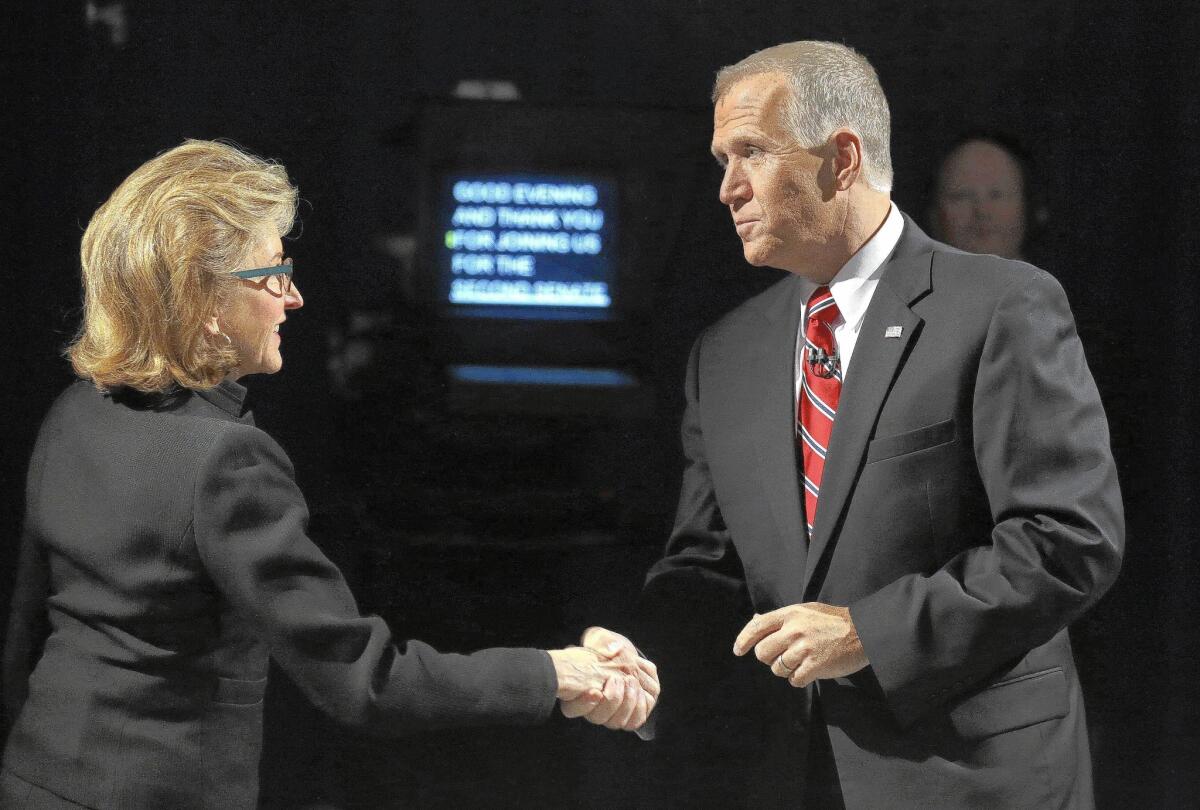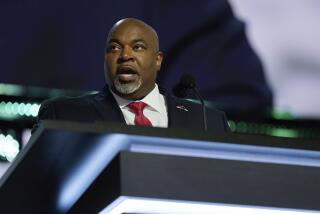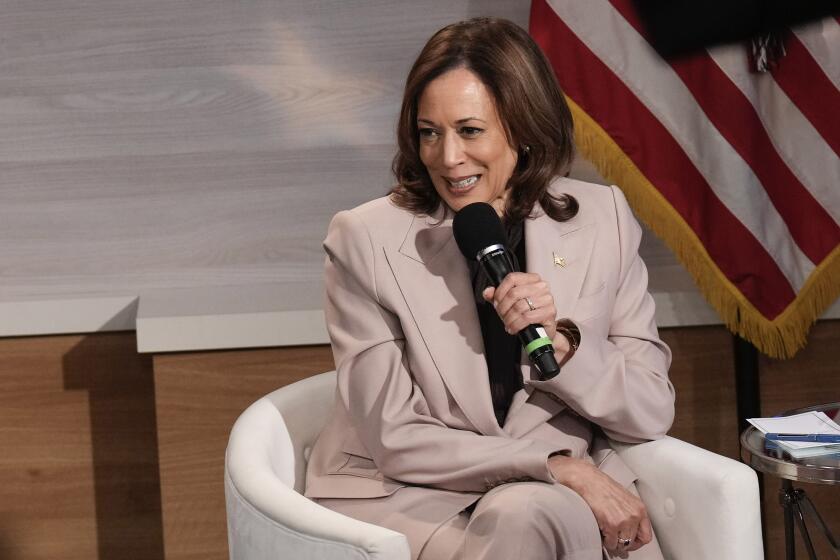Senate race in North Carolina brings avalanche of attack ads

In the seemingly endless and muddy slog of ads in North Carolina’s U.S. Senate campaign, weary viewers recently were faced with a dilemma: Which angry schoolteacher to believe?
“I always want my students to start with facts and the fact is, Thom Tillis is terrible for education in North Carolina,” grade-school teacher Vivian Connell says from a classroom in a commercial that attacks the school funding record of Tillis, the Republican candidate in the Senate race.
A few minutes later, another classroom: “As a teacher, when someone gets something wrong, I correct it,” says Judy Wilburn, asserting that Tillis raised education funding.
The commercials, aired by groups unaffiliated with the candidates, kept repeating, the teachers volleying back and forth with no referee to say whose facts were right.
And there were plenty more ads: On the same broadcast, the Chamber of Commerce praised Tillis’ business background, and the National Rifle Assn. celebrated him as a friend of the 2nd Amendment.
The ad war between Tillis, speaker of the state House, and his opponent, Democratic incumbent Kay Hagan, is emblematic of a new era of politicking driven by outside groups free to spend unlimited amounts of money, as long as they don’t coordinate with candidates.
The unrelenting din of ads began last fall in this closely divided state, a crucial battleground in the contest for control of the U.S. Senate. After nearly a year and $68 million worth of commercials, the race has barely budged.
Hagan recently opened a small lead thanks to a Democratic bombardment of the education-themed attack ads, but the Republican attacks have taken a toll on her, too. She is stuck at about a 43% approval level, a troubling spot for an incumbent.
“I don’t know if much of anything is working,” said Tim Boyum, host of Capital Tonight, a nightly cable show on North Carolina politics. “People are spending all this money, and what for? It becomes white noise.”
Voters may be reaching the point where “the marginal effect of another million dollars of ads is very, very small,” said Andrew Taylor, a professor of political science at North Carolina State University.
At the same time, he said, neither side wants to stop firing; research shows that not answering ads can cause a candidate to slip and the other side to gain ground.
About 80% of the spending in the race has come from outside groups, the largest percentage of any race in the country. Viewers in North Carolina have been hit with more than 62,000 television commercials in the Hagan-Tillis contest, more than any Senate race, according to an analysis by Kantar Media/CMAG and the Wesleyan Media Project. And that’s not counting ads online or on cable.
Many of the same outside groups are also spending big in other states with tight Senate races, including Colorado, Kentucky, Georgia and Alaska, making 2014 potentially the most expensive congressional midterm election in history.
This year, Democratic groups across the country have matched or beaten Republicans at outside spending, a change from the last two election cycles.
The Senate Majority PAC, a fundraising juggernaut led by Senate Majority Leader Harry Reid (D-Nev.), has spent $1.4 million to air ads supporting Hagan and $8.6 million on ads attacking Tillis, far more than it’s spent in any other state, according to data compiled by the Center for Responsive Politics. Other groups have already spent more than $14 million on Hagan’s behalf.
In North Carolina, each side carved out a narrative. Conservative groups tied Hagan tightly to Obama and his sinking poll numbers. Liberal groups have banged away at Tillis’ tenure as speaker of the state House, which pushed through a polarizing agenda after Republicans took over.
“North Carolinians aren’t getting to know either one of the candidates,” said Chad Adams, a former conservative talk show host who heads a nonprofit advocacy group. “Just a cacophony of special interests, and a massive battle for the middle-of-the-road voters.”
Betty Adams of Raleigh said she stopped listening a while ago.
“Character assassination is what it is. Over and over again, all day long,” Adams said. “I don’t pay any attention, really. I just wait for them to get off so I can watch what I’m watching.”
The ads come from an array of groups, all with their own priorities. The North Carolina League of Conservation Voters assailed Tillis for failing to crack down on polluters. Last week, the Women Speak Out PAC, an antiabortion group, bought $620,000 worth of airtime in the Raleigh television market to run commercials condemning Hagan’s record on abortion.
Conservative groups’ barrage against Hagan started last October, with $8.3 million in ads from the North Carolina chapter of Americans for Prosperity, the nonprofit linked to the billionaire Koch brothers, backers of a network of conservative political groups. The ads featured an elderly woman criticizing Hagan for her support of the Affordable Care Act. Crossroads GPS, another conservative group, added another $3.5 million in anti-Obamacare ads.
Hagan’s numbers went down, but the blow was hardly fatal. Carter Wrenn, a former Republican strategist who once ran campaigns for the late Sen. Jesse Helms, thought the Obamacare hand was overplayed.
“The people who were going to switch their vote on Obamacare got the message and did it pretty early,” he said. “They had already moved. There was no more milk left in that cow.”
Most of the Democratic attack ads have hammered Tillis for the Republican-dominated Legislature’s record on education spending, saying that he cut $500 million from the education budget. The truth is more nuanced — education budgets did increase, though by less than the amount considered necessary to avoid cuts in services — but the message found traction.
Republicans have been forced to respond, notably with the ad featuring the teacher Wilburn, sponsored by the conservative nonprofit Carolina Rising.
“I need more money,” complained Dallas Woodhouse, the group’s president. A former operative for the Americans for Prosperity chapter here, Woodhouse said it costs more than $1 million to run ads statewide for a week — and, as the election nears and time gets booked up, the prices increase and niches get harder to find.
“The audiences are so fragmented,” Woodhouse said, adding that he spotted some ads on a recent episode of the “Hoarders” reality show. “Who are the ‘Hoarders’ voters? I haven’t figured that one out.”
The roiling politics of North Carolina mean that spending wars like this one have become the new normal. Democrats hold a registration edge, 2.7 million to 2 million, but 27% of voters aren’t affiliated with either party. The state went for Obama in 2008 but for Romney in 2012.
The airwaves will only get more crowded between now and the election.
Candidates get cheaper rates than outside groups, and Hagan, with a significant cash advantage, has booked about $3 million more in ads than Tillis, said Patrick Ruffini, a GOP strategist and cofounder of Echelon Insights, an analytics firm that tracks media buys.
“Good luck trying to elbow into the conversation at this point,” Ruffini said. “A station can only hold so many ads, so 1 in 3 are going to be political towards the end — and that’s probably understating things.”
The ad war is a strong argument for campaign spending limits, said Rick Rook, an associate pastor at Zebulon First Baptist Church.
“What it’s doing is making people more disgusted with the political system,” Rook said, reading his Bible over breakfast on a recent morning at Big Ed’s City Market Restaurant in Raleigh. “Now imagine, if there is a problem with children in school not getting books, imagine the other uses, the other things that all those millions could be doing. How many schools could have been better?”
Twitter: @jtanfani
More to Read
Get the L.A. Times Politics newsletter
Deeply reported insights into legislation, politics and policy from Sacramento, Washington and beyond. In your inbox three times per week.
You may occasionally receive promotional content from the Los Angeles Times.











